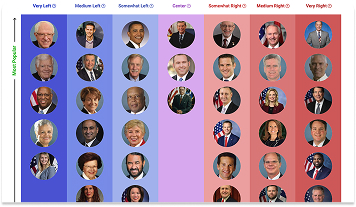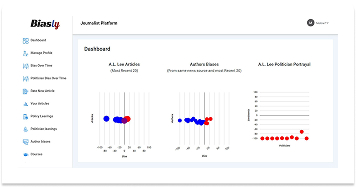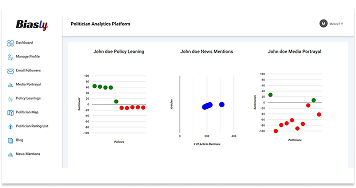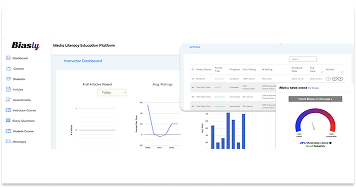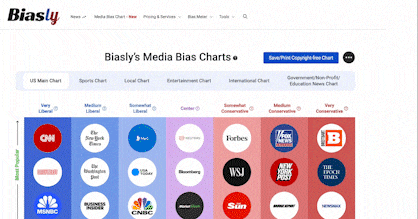Bias Meter
Extremely
Liberal
Very
Liberal
Somewhat Liberal
Center
Somewhat Conservative
Very
Conservative
Extremely
Conservative
-100%
Liberal
100%
Conservative

Biasly determines media bias ratings through a dual-layered approach combining artificial intelligence and analyst review. The platform’s proprietary bias detection engine, Bias Meter, evaluates sentiment, policy position alignment, and language framing across thousands of data points in news articles. Analysts then verify and interpret the AI’s findings, providing additional context where needed. Learn more
- Profile
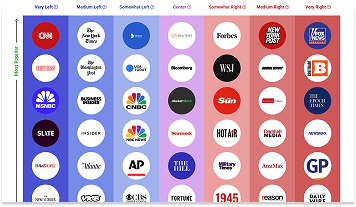
MSNBC on the media bias chart
MSNBC has a Bias Score of -38% Somewhat Left which is based on a variety of factors including its policy and politician leanings, article ratings, and the use of biased language. Its Reliability is rated as Average, and additional analytical insights are available in the other tabs.
- Bias Rating
-38% Somewhat Left
- ReliabilityPolicy Leanings
6% Center
Extremely
LiberalVery
LiberalModerately
LiberalSomewhat Liberal
Center
Somewhat Conservative
Moderately
ConservativeVery
ConservativeExtremely
Conservative-100%
Liberal100%
Conservative
Average Reliability
*Our bias meter rating uses data science including sentiment analysis, machine learning and our proprietary algorithm for determining biases in news articles. Bias scores are on a scale of -100% to 100% with higher negative scores being more liberal and higher positive scores being more conservative and 0% being neutral. The rating is an independent analysis and is not affiliated nor sponsored by the news source or any other organization.
Politician Portrayal64% negative
Continue For Free
Create your free account to see the in-depth bias analytics and more.
By creating an account, you agree to our Terms and Privacy Policy, and subscribe to email updates.
Policy Leanings Analysis
Policy | Bias score |
|---|
MSNBC Editorial Patterns
MSNBC’s coverage of political topics often reflects a Somewhat Left bias, with consistent patterns in phrasing, source selection, and thematic focus that are Lean Left. While the publication demonstrates journalistic standards in many of its reports, the choice of issues, framing, and word usage can indicate a political slant. This content analysis examines how MSNBC handles liberal and conservative issues and evaluates its language choices and editorial tendencies.
Coverage of Liberal vs. Conservative Topics
MSNBC’s articles often focus on issues central to the democratic party. These are issues like civil rights, the economy, and Congress’s legislation. Its coverage of these topics often aligns with liberal views. They often push for reader agreement, especially in their opinionated writing. At times, alternative ideological perspectives are limited, with conservative arguments receiving less emphasis.
Criticism of conservative positions appears frequently in coverage. Some stories are spun in a way that makes it seem like anyone who agrees with the conservatives is in the wrong. Biasly’s analysis of recent MSNBC’s writings has revealed a tendency to highlight how the Republicans are, to them, incorrect. Positive aspects of conservative positions are discussed briefly, if at all. For instance, during developing stories and/or controversies, MSNBC generally opposes the conservative stance on issues like civil rights and the economy.
These biases appear with varying subtlety, sometimes drawing primarily from left-leaning sources. Other times, they are present in opinionated articles that outright condemn the other party. Bias can also be seen in the omission of important contextual information, which agrees with MSNBC’s current rating of “Somewhat Left”. Bias appears in many forms, and the following sections outline some of the key patterns.
Policy and Issue Framing
When covering immigration, MSNBC often references inclusivity and representation, supporting politicians who advocate for regulating immigration less. This aligns with a Somewhat Left media bias, as MSNBC is vocal about this issue. Similarly, coverage of LGBTQ+ equality reflects a viewpoint in agreement with most of the Democratic Party. They often feature testimonials from LGBTQ+ people and detail laws that they believe are being used to restrict LGBTQ+ freedom of expression.
In contrast, issues like gun rights and non-renewable energy are covered in a more critical tone. These topics are usually talking points for the Republican Party, and heavily frowned upon by the left, of which MSNBC is a part. These stories are often contextualized through the lens of their impact on marginalized groups or framed as polarizing.
Even in neutral coverage, phrasing choices shape perception. Articles will describe liberal proposals as “expanding access” or “strengthening protections,” while conservative legislation may be described as “imposing limits” or “rolling back rights.” This consistent choice of words reflects an editorial direction that, even unintentionally, can contribute to bias in news media.
Coverage and Relevance
MSNBC’s frequently covers issues central to media-bias debates, including newspaper bias, bias in journalism, and partisan narratives. Its articles center on potentially divisive topics as well, including international trade and capitalism versus socialism. As such, it serves as a compelling case study for examining source bias and news media bias in state-focused reporting.
Readers who wish to further explore how MSNBC compares with other publications can visit Biasly’s Media Bias Chart to analyze tone and word choice in real time.
MSNBC Bias Analysis
MSNBC began as a joint venture between Microsoft and NBC in 1996. Today, it is a news outlet committed to spreading the word about many topics. These topics range from Congress to the Supreme Court, and even international politics. MSNBC is a large news source with a long-standing national audience. It also speaks often about the aforementioned topics, observing them through a left-wing lens.
According to SimilarWeb, MSNBC has an average of 19.1 million user visits per month. When it comes to media bias, both AI and media analysts have evaluated its content, sources, and funding to determine its political leaning.
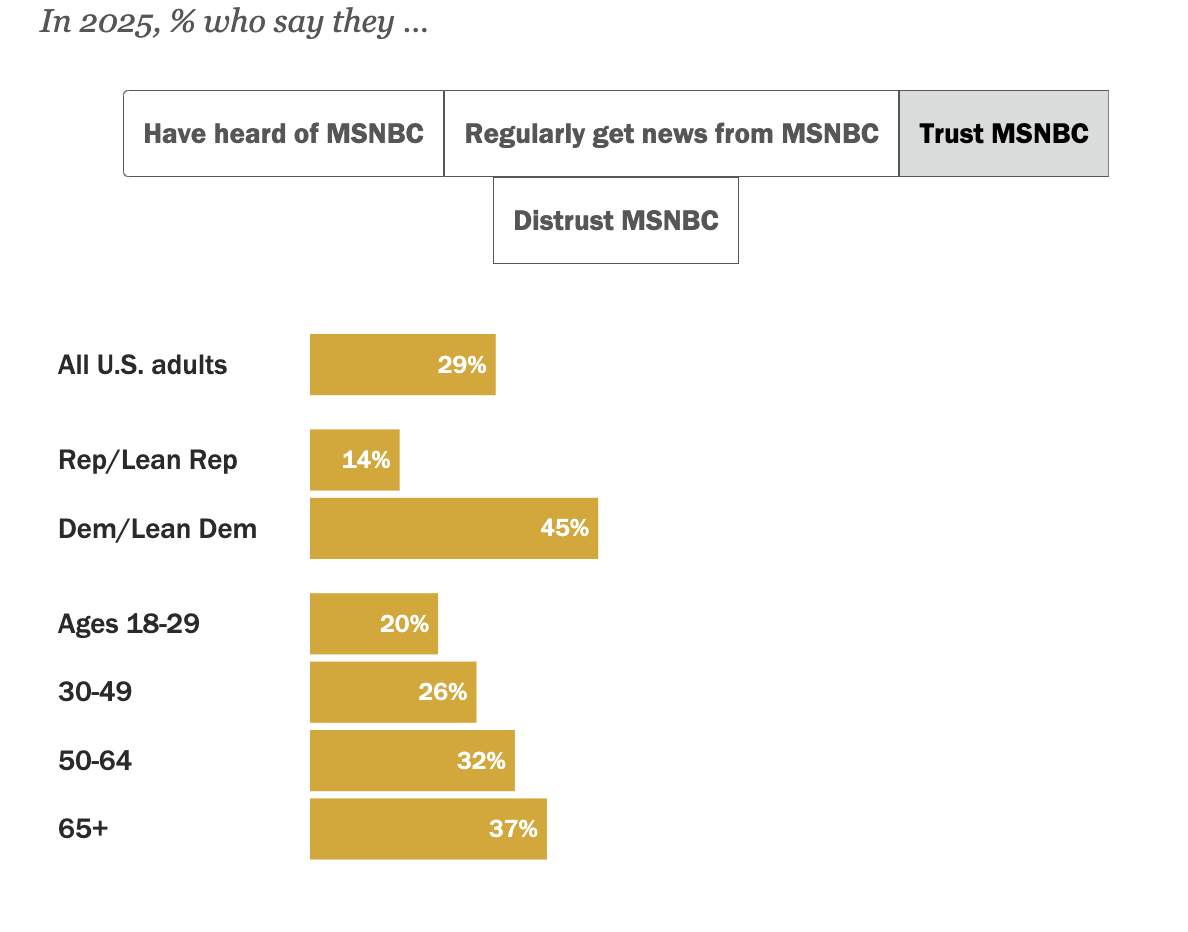
Source: Pew Research
As a leading media outlet in the United States, MSNBC plays a significant role in shaping public perception. This article delves into MSNBC’s editorial tendencies to explore whether political bias is present and, if so, to what degree.
Is MSNBC Biased?
Based on Biasly’s evaluations, MSNBC is rated as Somewhat Left.
By examining content patterns and the broader context of media influence, we aim to offer a balanced perspective on MSNBC’s political bias.
How Does Biasly Rate News Sources?
Biasly uses proprietary algorithms and a team of analysts to provide comprehensive bias evaluations across thousands of news outlets. Over 200,000 articles from more than 3,200 sources have been analyzed to identify the most accurate and unbiased stories.
Biasly assigns each outlet three key scores:
- Reliability Score – Reflects factual accuracy
- AI Bias Score – Generated via natural language processing
- Analyst Bias Score – Assessed by human political analysts
These scores are based on seven core metrics: Tone, Tendency, Diction, Author Check, Selection/Omission, Expediency Bias, and Accuracy. These elements help analysts and algorithms evaluate the political attitude conveyed by each article.
Biasly’s Bias Meter ranges from -100% (most left) to +100% (most right), with 0% indicating neutrality. The system evaluates individual articles based on political terms, policies, figures, and sentiment to calculate precise bias ratings.
Is MSNBC Politically Biased?
MSNBC earns a Somewhat Left rating for its AI Bias Score and a Somewhat Left for its Analyst Bias Score. The Analyst Bias Score is generated by reviewers from liberal, moderate, and conservative backgrounds. Analysts reviewed MSNBC articles and noted stronger preferences in areas like criticism of Donald Trump and support for LGBTQ+ equality.
For example, articles explaining certain policies and discussions of Supreme Court cases remain fairly neutral. Yet opinionated articles about today’s political climate contributed significantly to the liberal score.
A MSNBC writer noted in a report:
“The reality is there is no good option for Democrats. Unilaterally disarming against Trump as he pursues an autocratic agenda could be disastrous. But mimicking his antics also comes with costs and political risks, and could unravel valuable long-term efforts across many states to support independent redistricting. The conundrum speaks to the corrosive effect of living under a president who thinks rules are meant to be broken.”
This passage clearly reflects the writer’s viewpoint. According to research from Pew, in which viewer trust in MSNBC was examined, 45% of those who say they trust it lean Democrat.
Although Democratic-leaning viewers report higher trust, it is not universal. While smaller, there is still a portion of Republican leaning (14%) and independent (29%) adults who also trust MSNBC. This makes for a more varied audience than first thought, and may contribute to mixed reactions depending on readers’ political orientations.
This Bias score is determined through natural language processing that evaluates the tone, word choice, and opinion embedded in the reporting. Recent AI evaluations highlight liberal-leaning narratives in articles discussing the Republican Party and Congressional issues.
Analysis of Bias in MSNBC Online Articles
MSNBC has found that criticism of the conservative party/ideology is the best way to garner traffic. Given that much of its readership leans left, it’s essential to ask: is MSNBC truly biased?
To evaluate this, we can analyze select MSNBC articles through several of Biasly’s bias rating criteria: Tone, Tendency, Author, Diction, and Expediency Bias.
- Tone: The overall attitude conveyed by the article
- Diction: Specific word choices made by the writer
- Author: The background and social presence of the journalist
- Tendency: Patterns of bias in the writer’s broader body of work
- Expediency Bias: Quick visual or textual indicators like headlines and photos that imply bias

One such article features a headline that pins the blame for the apparent bad Bureau of Labor Statistics on President Donald Trump. The title uses inflammatory language to snag the audience’s attention. The article has an overall negative tone, starting off with the statistics and explaining that they believe the “economy could already be in trouble”.
Reporter Heather Boushey continues in a similar manner. For instance, there are other statistics and quotes from Donald Trump to highlight Boushey’s points. Boushey also uses instances of opinionated language within her article, offering up her and MSNBC’s perspective. While this lends weight to the article, it also reveals Boushey’s own viewpoint and raises questions about his objectivity.
“The administration’s economic agenda is driving up uncertainty and making everyday decisions for American businesses and consumers more difficult. Businesses can’t plan ahead, the manufacturing sector has shrunk for six straight months, and American workers are paying the price. A few months ago, Trump refused to rule out a potential recession, but predicted his policies “should be great for us.” This is far from “great” for working families.”
This article leans liberal in the way that it speaks of Donald Trump, often criticising the state of the economy under his Presidency. By using rather abrasive language, such as “sowed seeds of mistrust in the data” and “has an anti-worker agenda”, the author can forcefully make her points known. This framing of the issue lends this article a heavy liberal lens, further underscoring the article’s ideological slant.
On the other hand, another article titled “Trump administration asks Supreme Court for speedy tariffs review after appellate loss” is relatively more neutral. It explains the situation with very few instances of opinionated language. Phrases such as “expedited basis” and “momentous dispute” present information for readers to assess. What could potentially be an emotional topic for some is explained without bias:
“On the expedited timeline, the parties would submit their briefs ahead of a hearing the first week in November. The justices wouldn’t be on a deadline to rule after that (they usually decide the term’s cases by July); although if they agree to expedited consideration, then their ruling on tariffs could come much sooner.”
The article employs diction and language that are notably restrained and formal, contributing to its overall neutral tone. Terms like “challenges” and “advocate” are informative but measured, conveying the dynamics of the race without implying aggression or favoritism. The author also avoids emotionally charged words or loaded phrases often seen in more partisan outlets. Instead of framing the contest as a “battle” or “clash,” she refers to it as a “race” or “campaign,” maintaining an even-handed tone.
The language this article uses is more formal and geared not toward expressing the author’s thoughts but toward informing the public. There may be a few instances of bias, however. Examples can be found in the final paragraphs, where author Jordan Rubin states that this case “carries great implications for the economy and executive power”. He also criticizes what he calls the “Roberts Court”. These instances are brief, though, and the general tone of the article carries with it professional wording and clear information.
To conclude this section, MSNBC shows inconsistent bias throughout its reporting. Rubin’s article about speedy tariffs review stays mostly within the bounds of un-opinionated writing, explaining the facts with briefly biased language near the end. The article about August’s job reports slants significantly more to the left, shown through the headline’s phrasing and the way Boushey speaks of several politicians. Despite trying to remain balanced within some reports, MSNBC tends to consistently praise liberal ideology and demean the conservative one.
The stories are viewed through the lens that MSNBC offers its audience, which may sway the audience’s opinion in its favor. This can be seen particularly when discussing the current state of Congress or civil rights. More information about party stances can be found on Biasly’s ‘Political Party Stances‘ page.
Analysis of MSNBC Opinion Articles
To fully understand political bias in the media, it’s important to distinguish between factual reporting and opinion pieces. While reporting aims to present facts and let readers form their own conclusions, opinion articles express personal viewpoints on current issues. Although the previous section examined factual reporting, this section turns to how bias surfaces through MSNBC’s selection and tone of opinion content.
A great example of an opinionated article is the following: “Trump’s military crackdowns have put America at a tipping point”. Within the title itself, the author intends to make the audience feel negatively toward Trump and his military actions. There is an undercurrent of urgency, highlighted especially with “a tipping point”, which implies that we may tip in the wrong direction soon.
Another example is the article “How Uganda has become a petri dish for the American far right’s politics of intolerance”, which is also quite opinionated. The article speaks about how the author, Ja’han Jones, thinks that Uganda has become a sort of “trial government” for the United States. The language used within it is inflammatory. Examples are phrases such as “petri dish for an extremist Christian agenda” and “worst aspects of U.S. colonial power”. Bias is heavily present within this article, and Jones’ opinion fits with MSNBC’s rating.
These examples show that most of MSNBC’s opinion pieces tend to be liberal. The platform frequently publishes content that aligns with liberal media narratives. This consistent selection of opinion pieces can contribute to perceptions of systemic bias—particularly when the editorials predominantly support liberal views or causes.
This tendency underscores the importance of distinguishing subjective viewpoints from straight reporting, especially when interpreting the political leanings of any news organization.
Who Owns MSNBC?
MSNBC is a joint business venture between Microsoft and NBC News. As of 2025, the current President is Rebecca Kutler, who succeeded Rashida Jones.
MSNBC was founded in 1996, and its primary purpose was to serve as a competitor to the also recently established Fox News. Fox News leans right, and MSNBC toward the left. The objective was to provide an alternative perspective to the news bias that may have come with Fox News.
Today, MSNBC is still a prominent news outlet for many Americans, receiving about 23,700,000 monthly visits. It is not a non-profit company, though it still has donations open in case people wish to donate money. MSNBC has shareholders that they must help keep satisfied with their work. This may also impact their rating, as pressure from shareholders has them trying hard to keep their ratings up.
How to Evaluate Bias
Although Biasly rates MSNBC as Somewhat Left, it’s important to remember that bias can vary from article to article. MSNBC also publishes articles with only the purpose of informing. There is objectivity with issues such as tariffs and happenings in world politics. This complexity underscores the importance of examining each article individually. So, let’s learn how to evaluate media bias.
Recognizing media bias requires awareness and critical thinking. Often, readers trust news sources that affirm their existing beliefs, a psychological tendency known as confirmation bias. This makes it harder to identify slanted narratives or one-sided reporting.
To combat this, it’s essential to challenge your assumptions by consulting multiple viewpoints and verifying news through third-party analysis. Tools like Biasly’s media bias ratings allow readers to compare the same news story across the political spectrum.
Ultimately, bias isn’t always a matter of what is said, it’s also about what is left out, how topics are framed, and which stories are chosen for coverage. Learning to recognize these patterns can help readers make more informed decisions and develop greater media literacy.
To start comparing news outlets and gain a better understanding of bias, sign up for Biasly’s Media Bias & News Analytics Platform to see how stories vary between sources.
MSNBC Reliability Analysis
Is MSNBC Reliable?
MSNBC finds itself toward the middle of the spectrum, with neither high nor low accuracy. It is not by any means a small outlet, which may make reliability a more pressing topic. According to Pew Research’s article, most liberal-leaning audiences tend to have a wide variety of sources they get their news from. In the graphic presented, Pew shows that 33% of Democrats say that they regularly get news from MSNBC.
This suggests that MSNBC is possibly fighting for popularity within the democratic viewer sphere. Reliability may be taking a hit, as opinion articles have been shown as the best way to draw viewer attention. When more opinion articles are written, their viewership goes up, and their reliability may dip. Further investigation is needed to determine whether bias or other factors are affecting its accuracy. At Biasly, we specialize in evaluating not just bias but also the reliability of media outlets. Let’s explore the accuracy and trustworthiness of MSNBC.
How to Evaluate Reliability?
Reliability refers to how trustworthy or accurate a news source is. If we can’t trust what we read, then continuing to consume content from that outlet serves little purpose. So how do we evaluate a news outlet’s reliability?
There are several potential measures of reliability to look out for when trying to determine whether a media source is reliable or not. Red flags for an unreliable article can include the presence of wild, unsubstantiated claims, facts dependent on other unreliable sources, heavy use of opinionated language, and more. In contrast, hallmarks of a reliable source include:
- Absence of subjective language
- Citing credible sources (e.g., .gov, .edu, academic references)
- Verifiable facts and statistics from multiple outlets
- Use of primary sources, like interviews or transcripts
- Consistency with coverage across other platforms
Biasly’s reliability scores incorporate these elements in evaluating media outlets.
So How Does MSNBC Fare in Its Reliability?
The political reliability index developed by Biasly assesses both accuracy and trustworthiness. MSNBC currently holds Average Reliability Score, which is calculated as a weighted average of:
- Fact Analysis Score – Evaluates the accuracy of claims, facts, and evidence.
- Source Analysis Score – Assesses the number, diversity, and credibility of sources and quotes used.
MSNBC’s Source Analysis Score is Average at 65% Reliable. This suggests moderate trustworthiness in its sourcing practices. The score is AI-generated and considers quote length, frequency, diversity, and quality.
The Fact Analysis Score of MSNBC is Average at 69% Reliable. This further shows how well MSNBC supports its claims, addresses selection and omission bias, and presents verifiable evidence.
While MSNBC leans toward clearer reporting, occasional lapses, such as unbalanced viewpoints or incomplete data, can affect its reliability rating. These nuances emphasize the importance of analyzing individual articles.
MSNBC’s Accuracy and Reliability
According to Biasly’s analysis, MSNBC maintains Average Reliability Score, but individual articles may vary significantly. Let’s dive into the details.
Political orientation plays a crucial role in how audiences perceive reliability. MSNBC has been accused of favoring a liberal narrative, potentially at the expense of factual reporting. To validate such claims, it’s essential to analyze whether the publication backs its assertions with sufficient evidence and diverse viewpoints.
Two common types of bias that affect factuality include:
- Selection Bias – Highlighting or omitting stories to fit a particular narrative.
- Omission Bias – Leaving out differing perspectives or relevant details to skew perception.
Biasly’s accuracy ratings use a scale from 1% (least accurate) to 100% (most accurate). Factors include the presence of supporting evidence, internal and external reliable sources, and balanced viewpoints.
For example, Biasly gave the news outlet NBC News a Somewhat Left bias with a Good Analyst Reliability Score. One NBC article, titled “Lisa Cook’s bank documents appear to contradict Trump administration’s mortgage fraud allegations”, showed a Good reliability rating for their inclusion of multiple quotes from varied sources. They proceed to explain why they believe evidence from Federal Reserve board member Lisa Cook contradicts Donald Trump’s accusations against her. Even though the rating for reliability is good, author Steve Kopack failed to complement his selection of liberal sources with views belonging to any other school of thought.
In contrast, another piece from the NBC titled, “Trump lashes out at Israel after military strike in Qatar” was rated as Center and scored average for accuracy. The most significant language opposing liberal views here belongs to a politician, whose position naturally required involvement with local education systems. This article stays rooted in the center of the political spectrum and only occasionally includes bias within its writing. A few examples of biased language can be seen in quotes such as “ramped-up Israeli military operations in Gaza” and “dozens of deaths”, which may give the reader a more negative interpretation of these military actions.
We will take a closer look at more examples like this below to provide a further investigation into the reliability of MSNBC’s articles. This will include its use of selection bias, omission bias, and the quality of its sources and the facts it uses.
Analysis of Reliability in MSNBC’s Online News Articles
MSNBC strives to provide the United States with mostly opinionated reporting on happenings in the United States and world politics. Its staff is mostly writers who agree with this perspective. Most still also have the ability to write unbiased articles. However, readers should distinguish between news reporting and opinion pieces to evaluate credibility effectively.
One good example is the article “Trump, AI, and the mysterious case of the open White House window”. Reporter Steve Benen explains what had happened with the video circulating online at the time. From the second floor of the White House, a black bag and a long white object were thrown. Alongside factually describing the event, this article does include some opinionated language:
“His latest comment on the subject appeared designed to plant a seed in the minds of his followers: If you see something that paints the Republican administration in an unflattering light, it’s probably best to assume it was created by a computer.”
This piece illustrates what the overall tone of MSNBC’s articles tends to be like, and further agrees with Biasly’s media rating.
Quality of Sources and Facts Used
MSNBC often uses credible sources from across the political spectrum. However, some articles skew in how comprehensively they present opposing viewpoints.
The article “Trump’s tariffs are headed to the Supreme Court after a court ruled them illegal” is a good article to analyze, as it includes a variety of sources but still leans to the left. This article is opinionated and explains the situation with Donald Trump’s tariffs reaching the Supreme Court. It is well-documented and supported by quotes from Donald Trump’s speeches, alongside evidence from the previous Secretary of Education. However, there is still a distinct lack of content offering up perspectives from the right.
Readers cannot find any opposing perspectives within this article. Author Ray Brescia only describes the situation from a left-wing perspective and uses his own opinion frequently:
“Or can we expect this court to, once again, impose a different set of rules when it is a Trump policy that is being challenged?”
“The Trump administration exceeded its authority when it issued a range of far-reaching and sweeping tariffs on global trade.”
Concerning the people supportive of these tariffs, there is no mention of them or evidence of their support. This lack of information gives readers the impression that the tariffs should not have reached the Supreme Court, despite the fact that there are many who support them.
There are no points of view that align with those that support these tariffs. Brescia only offers his own perspective, which aligns with MSNBC’s. Within the article, there is only brief criticism about those who support the tariffs. This skews the perspective, as the number of people who support them is substantial.
This article references various sources to back up its point. There is a rather large amount of diversity within these, as some come heavily from the right and others heavily from the left. The majority of the sources only represent facts, and Brescia opines further upon them in his article. Readers are able to trust this article more because they may reference the statistics that Brescia relies on. The sources that are used in this article are the following:
- Federal Appeals Court
- President Donald Trump, recording posted onto X by a user
- Miguel Cardona, Secretary of Education under Ex-President Biden
- Betsy DeVos, Secretary of Education for President Trump’s 1st term
On the other hand, the article titled “Rev. Al Sharpton: Republicans and Democrats must unite to stop political violence” is much more neutral. It contains many quotes from Reverend Al Sharpton, yet these are presented as-is. The reader is allowed to interpret the quotes however they wish. There is no interference from the author in telling the audience what to think.
The article gains credibility through its 7 quotes from Reverend Sharpton—all of them somewhat medium length. These extensive quotations strengthen reliability by providing full context as to what he said. This offers readers a more authentic and trustworthy account from primary sources.
The article features two sources, Reverend Sharpton, and MSNBC’s host of The Weeknight. While the sources are only taken from this specific interview, they include some diversity. Reverend Sharpton and the co-hosts of The Weeknight come together even though they may internally hold different views. In this article, they agree that political violence is never a good thing, no matter what side of the spectrum you fall on.
- Reverend Al Sharpton, “Politics Nation” host
- The Weeknight Co-Hosts, Co-Hosts of MSNBC’s “The Weeknight”
The article accurately reflects both people’s viewpoints and word-for-word explains what Reverend Sharpton said. Controversial statements, such as “People on the left and the right have to unite”, are left up to the reader for interpretation with no sway coloring it.
The article relies on primary sources, which are highly valid and enhance its reliability. Given its focus on what has unfolded in the wake of Charlie Kirk’s assassination, including perspectives from everyone, may enhance the article’s credibility. However, this may not apply here, as Reverend Sharpton’s purpose was to increase unity in the wreckage of political violence.
Selection and Omission Bias
MSNBC provides extensive coverage of United States politics, as they are based in the United States. The vast majority of their readers also reside within the United States. However, bias may still emerge through framing and story selection.
In “Democrats are ready to fight in the mud with Trump. It could get messy.” selection bias surfaces through the article’s emphasis on negative aspects of the Republican party’s actions. The article does not explore positive opinions on the alleged gerrymandering of Texas. Still, it does remain rooted in verifiable quotes.
The article does not highlight any helpful or positive measures taken by GOP leaders when it comes to gerrymandering. Therefore, the article leans slightly left in its framing. The author addresses the issue of Texas’s alleged gerrymandering without exploring broader or contrasting perspectives. The report uses opinionated language such as “easily push democratic norms in the country backward for everyone” and “corrosive effect” to further cement its point.
By comparison, this article about Maine’s GOP lawmaker, Laurel Libby shows a stronger balance. Author Jordan Rubin includes quotes and opinions from various justices of the Supreme Court. Yet, a notable example of left-leaning bias can be found in this quote:
“The majority didn’t explain why it sided with Libby, which isn’t unusual for the court’s actions on the so-called shadow docket.”
Rubin cites multiple sources and focuses on factual description. He adds his own opinion subtly. The article integrated conversations that give some differing perspectives on lawmaker Libby’s situation. Rubin also referenced legal documentation that is readily available to the public for cross-examination and further analysis, which stands out as particularly objective fact reporting. Overall, Rubin used a well-rounded approach to delivering unbiased news to readers of MSNBC.
In opinion pieces, issues with factuality, sources, selection, and omission are frequently present. The articles we’ve covered so far reflect MSNBC’s Somewhat Left views, which may put its reliability into perspective. Its story selection favors issues that are more likely to concern liberals, making it safe to assume it neglects issues that highlight positive conservative ideology. MSNBC’s articles and authors often have an identifiable left-leaning bias.
So, Is MSNBC Reliable?
Overall, MSNBC can be considered an outlet that is moderately reliable. The site often prioritizes opinion-driven content, with variable sourcing and frequent editorial framing on sensitive international topics. While some claims are supported with evidence, consistency in sourcing and balance could be improved to meet stronger journalistic standards.
As media literacy improves, readers can more easily detect issues with selection bias, omission bias, and factuality. To strengthen your ability to assess reliability across the political spectrum, use the News Bias Checker to compare how multiple outlets report the same story.
This empowers you to consume more accurate, balanced, and dependable news.
Additional Insights
News Source Comparison
When it comes to news source comparison, MSNBC is often evaluated alongside other regional and national outlets that lean left or center-left. Sources like Business Insider, Vox, or MSN often present similar tones and editorial philosophies. MSNBC maintains a Somewhat Left media bias, and this rating is influenced heavily by the notable left-leaning bias in most articles.
This puts it in contrast with more objective media outlets that present consistently unbiased narratives with factual counterpoints. Readers seeking balanced political coverage may compare MSNBC’s framing of issues with outlets rated as Center or Lean Right on our Media Bias Chart, or explore other outlets on our Media Bias Chart.
Notable Contributors and Authors
MSNBC features varied reporters, many of whom are deeply familiar with democratic and republican ideology. Reporters like Steve Benen, who frequently cover political controversies and White House matters, exemplify the outlet’s strength in debating topics of national importance.
Other contributors focus on Congress, the economy, and the Supreme Court, topics central to the United States’ political discussion today. The presence of repeating authors helps readers evaluate individual journalists’ bias over time.
Related Tools and Resource Pages
To better understand how MSNBC fits into the broader media landscape, we recommend exploring these helpful resources:
- Media Bias Chart: See where MSNBC ranks among hundreds of media outlets across the political spectrum.
- Political Bias Chart: Visualize political slants of news sources across various policy areas.
- Journalist Bias Analytics Platform: Explore how individual journalists contribute to bias within their publications.
- Politician Bias Analytics Platform: Compare how politicians are framed differently by MSNBC and other outlets.
- Media Literacy Education Platform: Learn how to critically assess media sources, bias techniques, and news reliability.
Frequently Asked Questions
MSNBC is rated as Somewhat Left based on Biasly’s media bias algorithm, which assesses sentiment, article framing, and policy favorability.
Biasly uses a combination of AI sentiment analysis and human analyst review to assess tone, fact accuracy, source quality, and media bias indicators. Learn more on our Bias Meter page.
Yes, but with caution. MSNBC’s reliability rating is Average, and this is mostly affected by the degree of opinionated writing within articles. Articles labeled as “analysis” are usually more reliable for fact-based reporting, but all articles should be read carefully.
While MSNBC is not widely known for promoting fake news, numerous articles have shown selection and omission bias, especially in political reporting. Its factual reporting is generally sound, though all articles should still be analyzed with care.
Ratings are based on recent news using data science and A.I. technology.
Military Spending
| Date | Sentiment | Associated Article | Snippet |
|---|---|---|---|
| 08/25/2019 | 75% For | Trump Family Detentions Flores Agreement (link) | So, of course, the Trump administration is doing the opposite in a baldfaced |






















